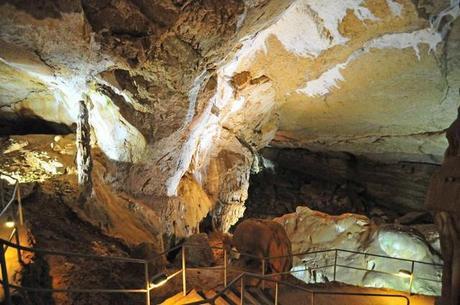The Marble Cave
Crimea is a great summer destination: sunny mountainous landscapes, the seaside promenade in Yalta, the invigorating Black Sea, well-preserved castles and palaces and more. Looking for an alternative to the bustling tourist spots and beaches? Just 17 km from Yalta on the way to Simferopol, near the village of Marmurove (“Marble”), lies the plateau called Chatyr-Dag. At 918 metres above sea level, this spot leads to an amazing netherworld.
Crimea’s karst plateau Chatyr-Dag, with its near-lunar landscapes, has more than 160 caves, wells and grottos. The temperature in this underground world is constant all year round at a cool +9 to +11ºС. Many local caves are worth exploring, such as Emine-Bair-Khosar, Thousand-Headed and Cold, but the best-known of them is the Marble Cave.
Speleologists of the Onix-Tour Speleotourism Centre of Simferopol discovered this natural wonder in 1987 and opened it to tourists. The Marble Cave is the true jewel in the crown of Chatyr-Dag, covering over 60% of the total plateau area and encompassing 40% of its karst deposits. In 1992, the Marble Cave was added to the International Show Caves Association.
The Marble Cave consists of three distinct parts: the straight Main Gallery (725 metres), the twisting Lower Gallery (960 metres) and the lateral Tiger Passage (390 metres). Local spelunkers believe that Marble Cave deserves inclusion in the list of the world’s five most beautiful caves, and it has a lot to offer: magnificent galleries of subterranean rock formations, huge halls beautifully decorated with stalactites and stalagmites and many inviting bends. Although speleologists have already explored 2,050 metres inside the cave, actual guide routes extend only for just half of that. Those without climbing or caving experience should not worry, as the entrance to this underground marvel begins with a 10-metre long man-made tunnel. The depth of the cave under the surface varies from just 10-80 metres.
Geologists say the Marble Cave takes its name from the surrounding rock in which the cave lies – a part of a block of Upper-Jurassic marbled limestone. They also believe that the Marble Cave is one of the oldest karst caves in the Crimean upland.
The cave “Master” greets guests at the entrance to this underground world. This massive stone block with moustache and helmet on his head is said to weep when warning cave explorers of danger. The scientific explanation for his tears stems from increased humidity inside the cave, which is dangerous for speleologists. So when water condenses on the stones near the entrance enough to make the stone Master cry, it is safer for tourists to postpone their visit.
Inside the cave, you will be awed by the amazing scale and age of the cave. It has taken Nature centuries to cover the cave walls with drapes of limestone and a carpet of sorts that resembles flowers. The cave also presents waterfalls, cascading lakes and picturesque columns that separate the various halls. Many stalagmites in the cave have been given names to describe their resemblance to surface beings: Mammoth, Dragon Head, Princess Frog and even Father Frost (which looks particularly bizarre in Crimea mid-summer). Archaeologists have found bones of pre-historic cave bears in one of the wells, so the Marble Cave has had its share of different visitors over the aeons. Perestroika Hall encloses tourists in perfect darkness – until headlamps are turned on, revealing a simply enormous space of 4,000 m2 with walls 20 metres high, making Perestroika Hall one of the world’s largest cave halls. And only in the Marble Cave can explorers see a unique seven-metre tall stalagmite which does not grow from the bottom, but lies on its side. Guides call this stalagmite the Fallen Tower.
There is also the Palace Hall, with statues of what look to be a King and a Queen welcoming tourists. Escorting the “royals” are various shaped stalagmite huddled around. Other halls worth visiting include the Hall of Roses, the Hall of Hopes, the Chandelier Hall, the Balcony Hall and the Chocolate Hall, among others.
One visit to the Marble Cave is often not enough for even amateur cave enthusiasts, and you will want to return to visit this quiet underground fairytale world.
You can get there by direct flight to Simferopol or through Kiev or Odessa. It is possible to get to the cave by public transport or by car (look for the Dobre-Tretie or Zarichne trolleybus stops, then head to Marmurove village). Try not to miss the turn near Zarichne at km 17 heading along the highway from Yalta to Simferopol. Buses and taxis run between the highway and the cave (approximately UAH 80 one way). The eight-kilometres track leading to the cave starts in the Marmurove village and runs through a forest preserve.




